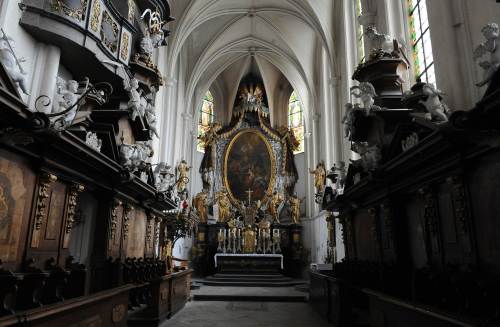ZELIV, Czech Republic (AFP) ― Religious belief may be on a sharp decline in the Czech Republic but the Zeliv monastery has found a new role as a spiritual refuge while it recovers from its own decades of turmoil.
Today’s pilgrims to the monastery tucked in a picturesque valley outside Prague include businessmen, managers and artists ― even a 1970s pop star ― who come to follow the steady rhythm of a monk’s life even if just for a few days.
They stay in Spartan cells, decorated with simple crosses on the walls, and abide by the daily routines of the monastery, starting with morning prayers, but sometimes with dancing and music classes added on.
“We offer our visitors the possibility to relieve the tension that life brings,” said Jachym Jaroslav Simek, the provisor or second in rank at the monastery of the Catholic order of the White Canons.
Today’s pilgrims to the monastery tucked in a picturesque valley outside Prague include businessmen, managers and artists ― even a 1970s pop star ― who come to follow the steady rhythm of a monk’s life even if just for a few days.
They stay in Spartan cells, decorated with simple crosses on the walls, and abide by the daily routines of the monastery, starting with morning prayers, but sometimes with dancing and music classes added on.
“We offer our visitors the possibility to relieve the tension that life brings,” said Jachym Jaroslav Simek, the provisor or second in rank at the monastery of the Catholic order of the White Canons.

“We organize debates and spiritual exercises but the main thing is that visitors can be alone for some time so they can calm down and perceive their internal stimuli,” Simek said.
“This begins to work in about two or three days,” he added with a smile.
Looking for refuge in meditation is unusual in this former communist country where two in three inhabitants claim they are non-believers.
Unlike in neighboring Poland or Slovakia, religious belief has been in steady decline in the nation of 10.5 million, which gained independence as the Czechoslovak federation split in 1993.
The country has a strong Hussite Protestant, anti-Catholic tradition, which was stoked by the 1948-1989 communist regime that described the Catholic Church as a public enemy.
Despite this wariness, the Catholic Zeliv monastery, about 90 kilometers southeast of Prague, hosted a healthy 3,000 visitors in 2010.
One was 1970s Czech pop icon Nada Urbankova who said her retreat provided rock-solid comfort amid personal and health problems.
“When I found myself in a difficult situation, my friends from Zeliv offered me a helping hand,” said the singer, who first visited five years ago.
“Having friends who help you is very valuable. And my way to God got a boost,” she added.
Another visitor, Prague marketing agent Jana Jurkova, enthuses that guests “experienced the feeling of not being simply visitors but pilgrims who have achieved a new perception of time and space.”
“In Zeliv, you find yourselves in a different world with a rhythm quite unlike in the world outside, where it’s determined merely by deadlines,” she said.
The monastery ― founded in virgin forest in 1139 ― is also living its own period of calm after a tumultuous history.
Over the course of the years, it was burned down several times and rebuilt, with its current appearance in a unique Gothic-Baroque style that is the work of Giovanni Blasius Santini (1677-1723), a Czech architect with Italian roots.
After the communists took power in 1948, it served as a detention facility for clergy. “A total of 464 priests were imprisoned here in 1950-1956,” said Simek.








![[Kim Seong-kon] Democracy and the future of South Korea](http://res.heraldm.com/phpwas/restmb_idxmake.php?idx=644&simg=/content/image/2024/04/16/20240416050802_0.jpg&u=)







![[KH Explains] Hyundai's full hybrid edge to pay off amid slow transition to pure EVs](http://res.heraldm.com/phpwas/restmb_idxmake.php?idx=652&simg=/content/image/2024/04/18/20240418050645_0.jpg&u=20240418181020)

![[Today’s K-pop] Zico drops snippet of collaboration with Jennie](http://res.heraldm.com/phpwas/restmb_idxmake.php?idx=642&simg=/content/image/2024/04/18/20240418050702_0.jpg&u=)